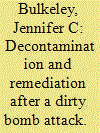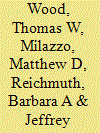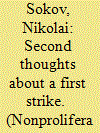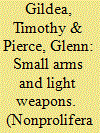|
|
|
Sort Order |
|
|
|
Items / Page
|
|
|
|
|
|
|
| Srl | Item |
| 1 |
ID:
076775


|
|
|
|
|
| Publication |
2007.
|
| Summary/Abstract |
In the aftermath of September 11, 2001 and Hurricane Katrina, the United States government has spent tens of billions of dollars to improve the nation's ability to respond to a natural disaster or terrorist attack, but the emphasis on immediate first response has left many long-term environmental, political, and technological challenges unaddressed. Although a dirty bomb attack is unlikely to yield the same amount of physical devastation and death as caused by Katrina or a nuclear weapon, the social, psychological, and economic impact would be enormous. At present, however, the United States lacks the technology necessary to decontaminate a large, densely populated urban area under time, political, and economic constraints. This article reviews past cleanup experiences and current decontamination capabilities to consider the long-term implications of a dirty bomb, identifies weaknesses in America's existing response capabilities, notes possible areas of political friction, and considers the implications of the failure to adequately prepare. Having the appropriate decontamination techniques established and long-term plans in place before an incident occurs will significantly improve the government's ability to protect public and environmental security, establish a viable decontamination strategy, allow residents to return to their homes, and get the local economy back on its feet.
|
|
|
|
|
|
|
|
|
|
|
|
|
|
|
|
| 2 |
ID:
076774


|
|
|
|
|
| Publication |
2007.
|
| Summary/Abstract |
Iran has pursued an ambitious nuclear program with the declared goal of long-term energy independence. While this is a worthwhile and generally accepted national planning objective, it is clear that Iran's nuclear program as now structured will not achieve this goal, and in fact may delay it by diverting capital and other resources from projects that would address pressing current energy sector problems and contribute to ultimate energy independence for Iran.
|
|
|
|
|
|
|
|
|
|
|
|
|
|
|
|
| 3 |
ID:
076773


|
|
|
|
|
| Publication |
2007.
|
| Summary/Abstract |
Scholarly and popular literature in the recent past has framed nonproliferation diplomacy toward both Iran and North Korea as an example of "good cop/bad cop," a social-psychological strategy borrowed from law enforcement to describe a process for forcing a confession by subjecting a target to stressful emotional contrast. This article examines those two cases, roughly covering the period since 2003, when the most recent attempts to deal with the Iranian and North Korean proliferation threats began, in light of criteria for employment of the good cop/bad cop strategy. There is some evidence that within the framework of the six-party talks with North Korea and within the framework of the EU-3-U.S. diplomacy toward Iran, the players seeking nonproliferation have adopted good cop/bad cop roles to that end. The article concludes, however, that while there are similarities to the interrogation room technique, the complexity of the international political environment as compared to the interrogation room has prevented the states involved from successfully adopting or effectively exploiting good and bad cop roles. Substantial and exploitable differences of interest among them, and the availability of alternative "escape routes" for the target state, raise serious questions about the applicability of the good cop/bad cop strategy to these two nonproliferation cases, and even about its applicability in future nonproliferation challenges
|
|
|
|
|
|
|
|
|
|
|
|
|
|
|
|
| 4 |
ID:
076772


|
|
|
|
|
| Publication |
2007.
|
| Summary/Abstract |
Abstract Recently, post-explosion nuclear forensics, or nuclear attribution, has gained a new spotlight within the nuclear weapons scientific and policymaking community. Academics are beginning to ask whether post-explosion forensics might create a replacement for an international nonproliferation regime, or at least offer a fallback option to deter states and individuals from selling nuclear materials. This paper examines current attribution technology from unclassified literature and finds the technology to be well developed but not foolproof, such that nuclear attribution currently provides little deterrent value. If current capabilities were publicized more thoroughly and if the post-explosion process of assessing the evidence were internationalized, states and intermediate actors might be deterred more effectively. Developing a nuclear fingerprint database is also discussed. While useful, its impact on deterrence would be minimal.
|
|
|
|
|
|
|
|
|
|
|
|
|
|
|
|
| 5 |
ID:
076776


|
|
|
|
|
| Publication |
2007.
|
| Summary/Abstract |
This article critiques recent articles in Foreign Affairs and International Security that argue that in the foreseeable future the United States could acquire an assured first-strike capability vis-à-vis Russia and China thanks to technological improvements in U.S. nuclear delivery systems and a general decline in the numbers and capabilities of Russian nuclear forces. Notwithstanding these articles, this analysis finds that mutual deterrence will persist regardless of the scale of possible future imbalances because deterrence is a highly flexible phenomenon. The pertinent question is not whether the United States will be able, in a surprise first strike, to cripple severely Russian response capabilities, but whether political stakes in any foreseeable conflict could justify the risk of even a small retaliatory strike on the United States. This article also assesses whether the Foreign Affairs and International Security articles could inadvertently exacerbate an already highly charged anti-American sentiment in Russia, possibly laying the foundation for a revitalization and expansion of the Russian nuclear arsenal.
|
|
|
|
|
|
|
|
|
|
|
|
|
|
|
|
| 6 |
ID:
076771


|
|
|
|
|
| Publication |
2007.
|
| Summary/Abstract |
The impact of small arms and light weapons (SALW) trafficking on civilian populations has received increasing attention from nongovernmental organizations (NGOs), academic institutions, national governments, and international organizations. Within the last 10 years it has been internationally recognized that the proliferation of SALW to areas of civil conflict has led to what the Red Cross describes as "appalling levels of wanton violence." Concurrent with the increased focus on the destructiveness of SALW is the realization that present national and international import/export regulatory systems are inadequate to meet the challenge of controlling the proliferation of these weapons. Needed in this area of study is more specific information and policy guidance regarding the best methods and practices for implementing effective SALW trafficking controls. In response to the international SALW trafficking problem, this article provides a comprehensive framework to assess the development and operation of international small arms control regimes. It uses the U.S. export control regime as a case study to document, assess, and benchmark how import/export control systems can be optimally employed to control the international SALW trade.
|
|
|
|
|
|
|
|
|
|
|
|
|
|
|
|
| 7 |
ID:
076778


|
|
|
|
|
| Publication |
2007.
|
| Summary/Abstract |
Since the early 1950s, nuclear reactors have been periodically advocated for use in space. Recently, there has been a resurgence in promoting nuclear reactors as a viable and necessary component to future space exploration. This article describes various nuclear power sources for space use, explains the desirability of space reactors relative to other forms of power generation, examines the history of their development and use, and considers the difficulties presented for future engineering and production. It demonstrates how current space policy is deficient with regard to regulating the expected development and use of nuclear reactors in space. Because of the extended time frame required for development and testing, a comprehensive policy should be created to allow for the safe and publicly acceptable use of space-based reactors. To that end, the report concludes with three recommendations to advance space nuclear reactor policy.
|
|
|
|
|
|
|
|
|
|
|
|
|
|
|
|
| 8 |
ID:
076777


|
|
|
|
|
| Publication |
2007.
|
| Summary/Abstract |
In February 2006, the Department of Energy (DOE) released its historical account of U.S. production and disposition of highly enriched uranium (HEU) through 1996. The report was unclassified and had been completed in 2001, but it required five years of petitions and appeals under the Freedom of Information Act (FOIA) before the Bush administration was forced to release it. According to the report, in 1996 the United States had a stockpile of 741 metric tons (MT) of HEU with an average enrichment of 84 percent. Of that stockpile, 178 MT of HEU with an average enrichment of 62 percent had been declared excess for military purposes. In 2005 and 2006, an additional 70 MT was declared excess and 138 MT was put into a reserve for future use as naval reactor fuel. An estimated 5 MT of HEU was lost due to "normal operating losses," and there was a residual discrepancy of about 3 MT between the number obtained by subtracting cumulative disposition from cumulative production and the actual 1996 stockpile. This article discusses the value of this information and provides insights about the feasibility of declaring additional U.S. weapons HEU excess and the ultimate limits of nuclear disarmament verification
|
|
|
|
|
|
|
|
|
|
|
|
|
|
|
|
|
|
|
|
|